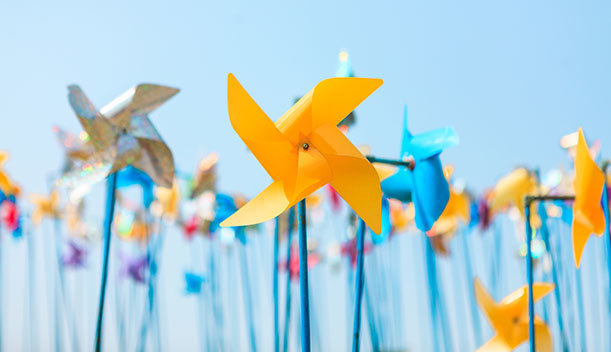BOOMbox at Home: Pollution and Renewable Energy
March 9, 2021

During spring, we're exploring the four elements of earth, air, fire, and water. This week, we’re exploring air and wind. We’re going to learn more about air pollution and its effects, and how wind is used as a renewable energy resource.
Air Pollution
According to NASA, air pollution is caused by solid and liquid particles and certain gases that are floating around in the air. These particles and gases can come from car and truck engines, factories, airplanes, dust, pollen, volcanoes, and wildfires. Small solid and liquid particles suspended in air are called aerosols.
In big cities, a gas called ozone is a major cause of air pollution. High in our atmosphere, ozone is a good thing. It helps block harmful radiation energy from the sun. But, when ozone is closer to the ground, it can be unhealthy. Ground-level ozone is created when sunlight reacts with certain chemicals that come from sources of burning fossil fuels, such as factories or car exhaust. When particles in the air combine with ozone, they create smog. Smog is a type of air pollution that looks like smoky fog and makes it difficult to see.
If you want to learn more about air pollution and how it affects us, check out these resources:
- What Causes Air Pollution? (Video)
- Air Pollution: Causes, Effects and Solutions (Video)
- National Institute of Environmental Health Sciences: Pollution
- Environment for Kids: Air Pollution
Renewable Energy: Wind Power
A lot of air pollution comes from burning fossil fuels like coal and oil. Burning these fuels in factories creates sulfur dioxide, carbon dioxide, and other greenhouse gases. Large quantities of these gases can create smog and even affect global warming. One way to reduce air pollution is to use renewable energy.
Wind turbines are a renewable energy source that work in the opposite way of a fan. Instead of using electricity to make wind, a turbine uses wind to make electricity. The wind turns the blades, which spin a shaft, which connects to a generator and makes electricity. The electricity is sent through transmission and distribution lines to a substation, then on to homes, businesses, and schools.
Did you know that a single large wind turbine used instead of burning coal can prevent 5,000 tons of carbon dioxide emission each year? That’s the same weight as 35 blue whales! It goes to show just how effective renewable energy and wind power can be.
If you’ve ever wanted to see a wind turbine in action, check out this 360° VR windmill tour of one of the turbines located at the Whispering Willow Wind Farm in Iowa.
The best way to learn more about how windmills work is to make your own miniature one. These DIY paper pinwheels are a great way to take advantage of a windy day.
Air Quality Experiment
Have you ever sat next to a bright window and seen a bunch of particles floating in the air? Those particles are usually made up of skin cells, dust, animal fur, carpet fibers, or other matter found in your home. With this DIY air quality experiment, you’ll be able to see what’s in the air you're breathing and what the air quality in your home is like.
For this project, you will need the following supplies:
- Clear plastic plates
- Permanent marker
- Petroleum jelly or Vaseline
- Tape
- Blank pieces of paper
- Magnifying glass or phone camera
Instructions:
- With a permanent marker, label each plate with a different location around the house, like your bedroom, kitchen, living room, or bathroom.
- Spread a thin layer of petroleum jelly on each plate. Use the same amount of petroleum jelly on each plate.
- Hang each plate in its room using tape.
- Wait two to three days, then collect your plates.
- Place each plate on a piece of white paper, and observe all the different particles that were collected through a magnifying glass or a camera.
Scientist of the Week
Lisa P. Jackson is a chemical engineer who graduated from Princeton University. Appointed by former U.S. President Barack Obama, she served as the first Black administrator of the Environmental Protection Agency (EPA) from 2009 to 2013. During her time as an administrator, Lisa declared carbon dioxide a public health threat and enforced stricter CO2 and smog pollution limits.
Currently, Lisa is Apple’s vice president of environment, policy, and social initiatives. In this role, she works to minimize Apple’s impact on the environment. Ever since Lisa joined the company, Apple has transitioned to running 93% of their operations on renewable energy and are creating 99% of their packaging from recycled paper or paper harvested from trees in sustainably managed forests. The company has also created new ways to recycle iPhones down to their simplest components.
Written by Mahnoor.